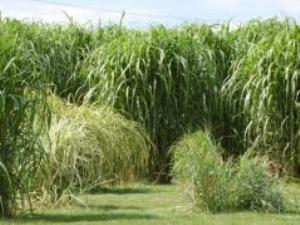May 16 2013
Two University of Illinois scientists have developed an environmentally friendly and more economical way of pretreating Miscanthus in the biofuel production process.
 Miscanthus
Miscanthus
“We pretreat the biomass with switchable butadiene sulfone in the presence of water to break down the plant cell wall, which consists of cellulose, hemicellulose, and lignin, the source of biofuels and value-added products,” said Hao Feng, a U of I professor of food science and human nutrition who also has extensive research experience with biofuels.
The new technique is a green alternative to current industry practices because butadiene sulfone can be recovered at potentially high yields since the solvent’s decomposition gases are also the raw materials for its production. This means that butadiene sulfone can be re-used after pretreatment, he added.
The commercial availability for both production and recovery of this chemical should allow for a transfer of these operations into a biorefinery, Feng said.
“It’s a big advantage in terms of both economy and environmental impact,” he added.
The current chemical pretreatment process uses relatively harsh conditions to break down the tough structure of grass and other biomass. Enzymes are then used to release the sugars that are converted to fuels through a fermentation process, Feng explained.
“These chemicals not only produce compounds that are toxic to fermenting microorganisms, they often result in by-products that have negative environmental impact,” he said.
Why is this new solvent so important? “Pretreatment is the most expensive step in the production of biofuels and chemicals from lignocellulosic biomass,” said J. Atilio de Frias, co-author of the study and a doctoral student in the Feng laboratory.
According to de Frias, butadiene sulfone has the unique ability to “switch” in equilibrium to 1,3-butadiene and sulfur dioxide at relatively low temperatures, forming sulfurous acid in the presence of water.
Using this relatively inexpensive and recoverable chemical to pretreat biomass in one step under mild conditions is definitely a step in the right direction, he said.
“At temperatures ranging from 90ºC to 110ºC, the sulfurous acid hydrolyzes hemicellulose. Then butadiene sulfone helps to solubilize lignin with most of the cellulose preserved for downstream enzymatic hydrolysis,” he explained.
The scientists said their data shows promise for the separation of hemicellulose and lignin and for the preservation of cellulose. They were able to remove up to 58 percent of lignin and 91 percent of hemicellulose and preserved 90 to 99 percent of cellulose.
Feng said that this is the first time that this solvent has been successfully used as a pretreatment in biofuel production.
“We look forward to its testing and adoption by biofuel manufacturers that are working with Miscanthus and other biomass crops,” he said.
“Switchable butadiene sulfone pretreatment of Miscanthus in the presence of water,” co-authored by J. Atilio de Frias and Hao Feng, was published in Green Chemistry (2013, 15, 1067-1078).